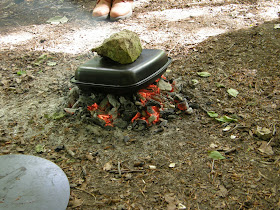
My elder son had a day off work last Thursday, he suggested packing a picnic and taking Kaitlyn for a walk in Monsal Dale so off we went.

Eagle eyed K spotted this little beetle almost as soon as we set off, neither Steve nor I would have seen it at all as it was only tiny, less than quarter of an inch long, but such a lovely colour. I have no idea what kind of beetle it is so any suggestions would be welcome.
Added later - Thanks to Kate the mystery is solved, I looked up 'red weevil' and came up with the Red Rumex Weevil which is exactly like my photograph, it lives on docks and sorrels. Well done Kate!

After walking across the viaduct, which used to carry the railway line from Bakewell to Buxton, we turned off to the left and started to climb up a stony pathway towards the ridge. There were wildflowers growing in profusion, on both sides of the track were swathes of cowslips. Monsal Dale is a Site of Special Scientific Interest and also a Special Area of Conservation. The wildflower-rich grasslands of this and other limestone valleys in the area are of international importance.

We saw lots of rabbits - I don't think these are among the rare species in Monsal Dale!

The track is quite steep especially for little legs but after a picnic lunch we had renewed energy and onwards and upwards we went through one of the squeezer stiles that are common in Derbyshire.

At last - we made it to the top and were rewarded with a beautiful view and the sight of new twin lambs having their lunch.

Violets growing in a shady area, I can't remember ever seeing quite so many - like handfuls of amethysts scattered across the landscape.

More of the wildflowers, if you click on the photo to enlarge it you will see wild strawberries (white), bugle (the dark blue spires), ladies' bedstraw (yellowy green) and field speedwell(light blue). The ladies' bedstraw was dried and used to stuff mattresses, as with sweet woodruff the scent increases as it dries. It is also a dye herb and was used in cheesemaking as it will curdle milk when it is boiled.

One of Kaitlyn's favourite pastimes is jumping in puddles - the muddier the better! Fortunately there were quite a few along the track which helped us encourage her onwards as her legs tired to 'look for another muddy puddle'!

Another kind of style - this step style took us over the wall to begin the downhill part of the walk.

Still marching gamely on ahead of the other explorers.

The track was in shade here as it lead down towards a farm, I love the way the stones are covered with a thick blanket of moss.

The farmyard nursery where the ewes who have recently or are about to lamb are kept. The weather can be very bleak up here and lambing is much later than on the lowland farms.

Eventually we came back into the valley bottom and came upon this big patch of marsh marigolds. We always called them Kingcups when I was a child.

Marsh marigolds have lovely glossy leaves and are loved by bees, hoverflies and other insects. They provide good cover for frogs when they are growing by the water's edge too.

Having fun in one of the tiny streams that flows down to the River Wye.

Walking along by the river we eventually came to the weir which can be a very spectacular sight in the winter or after heavy rain. From here the path climbs steeply upwards back to our starting point at Monsal Head. Small legs gave out half way up and daddy had to carry Kaitlyn the last few hundred yards. The walk was over 3 miles and this was the first time she needed to be carried - not bad for someone who only had their 3rd birthday at the end of April.

Back at the top and looking back over our route. It's a poor photo as the sun was streaming in from the lefthand side. The viaduct which carried the railway is now considered to be an elegant feature of the landscape and has a preservation order on it. There was considerable opposition to it when it was built in 1863 especially by
John Ruskin who wrote these words which give a lovely description of the valley -
"There was a rocky valley between Buxton and Bakewell, once upon a time divine as the Vale of Tempe; you might have seen the Gods there morning and evening - Apollo and all the sweet Muses of the light - walking in fair procession on the lawns of it, and to and fro among the pinnacles of its crags."




















































